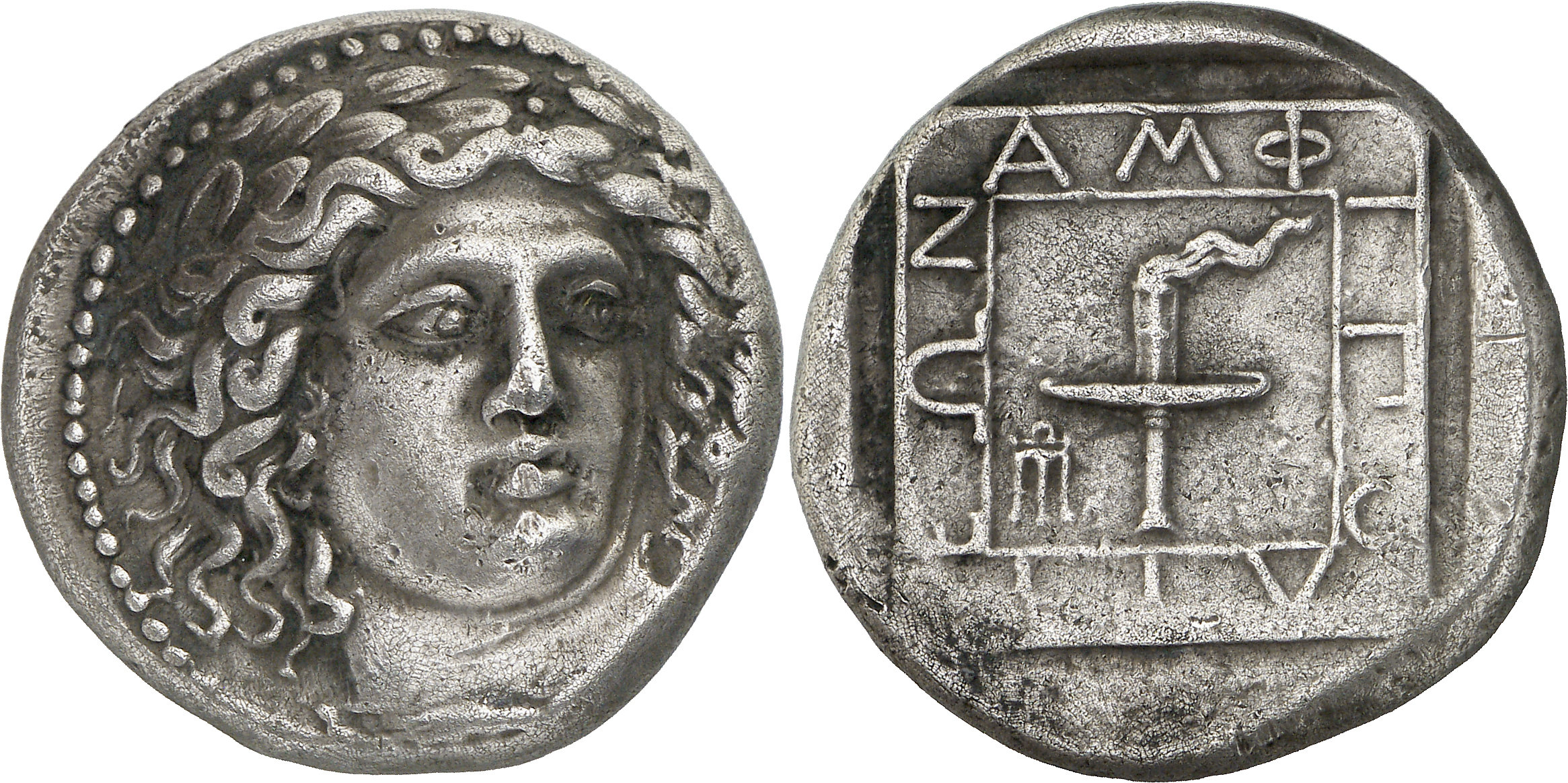Amphipolis, silver, tetradrachms (370-353 BCE)
From SILVER
370 BCE - 353 BCE Silver 9,727 kg
Description
| ObverseInscription or printing placed on the obverse.: | Head of Apollo facing, slightly inclined to right, wearing a laurel-wreath |
| ReverseInscription or printing placed on the reverse.: | AMΦ-IΠO-ΛIT-EΩN (Greek).AMΦ-IΠO-ΛIT-EΩN on a broad frame of a raised linear square enclosing a race-torch, a tripod on inner left, all within a broad shallow incuse square |
Mint and issuing power
| MintIdentifies the place of manufacture or issue of a numismatic object.: | Amphipolis | Ancient regionAncient region.: | Macedon | Modern countryModern country: Greece | AuthorityIdentifies the issuing power. The authority can be "pretended" when the name or the portrait of X is on the coin but he/she was not the issuing power. It can also be "uncertain" when there is no mention of X on the coin but he/she was the issuing power according to the historical sources: |
Chronology
| FromIdentifies the initial date in a range assigned in a numismatic context. | 370 BCE | toIdentifies the final date in a range assigned in a numismatic context.. | 353 BCE | PeriodTime period of the numismatic object.: Classical 480-323 BC |
Physical description
| MetalThe physical material (usually metal) from which an object is made.: | Silver |
Median weightMedian of the weights of numismatic objects (in grams). in grams | 14.20 | DenominationTerm indicating the value of a numismatic object. Examples: tetradrachm, chalkous, denarius.: | tetradrachm |
StandardStandard.: |
Image

S1848 Amphipolis tetradrachms.jpg [1]
References
| Die study referencePublication of the study: | Lorber 19901Lorber 1990, p. 117-138 | ||
| Coin series referenceReference to coin series study: | Sear I2Sear I, n° 1378-1379, RQEMAC3RQEMAC, n° 149, HGC 3.14HGC 3.1, n° 417 | ||
| Coin series web referenceCoin series web references: |
| ||
Obverse dies distribution
| FrequencyFrequency of specimen in distribution. ᵖ | Number of obversesNumber of obverse dies. ᵖ (o) | % (o) | Number of coinsNumber of coins. (n) | % (n) | Die nameName(s) of the die(s). |
| 1 | 5 | 17.24 | 5 | 4.55 | 4, 7, 18, 22, 26 |
| 2 | 6 | 20.69 | 12 | 10.91 | 2, 5, 17, 23, 25, 27 |
| 3 | 6 | 20.69 | 18 | 16.36 | 10, 12, 19, 20, 24, 29 |
| 4 | 3 | 10.34 | 12 | 10.91 | 1, 16, 28 |
| 5 | 3 | 10.34 | 15 | 13.64 | 11, 13, 14 |
| 6 | 2 | 6.9 | 12 | 10.91 | 3, 9 |
| 7 | 1 | 3.45 | 7 | 6.36 | 21 |
| 8 | 1 | 3.45 | 8 | 7.27 | 8 |
| 10 | 1 | 3.45 | 10 | 9.09 | 15 |
| 11 | 1 | 3.45 | 11 | 10 | 6 |
| Total | 29 of 29 | 100 | 110 of 110 | 100 |
Reverse dies distribution
no distribution is available
Quantification
| Number of obversesNumber of obverse dies. ᵖ (o) | 29 | Number of singletons (o1)The number of singleton coins. ᵖ | 5 |
| Number of reverse diesNumber of reverse dies. (r) | 42 | Number of coinsNumber of coins. (n) | 110 |
| Coins per obverse dieNumber of coins per obverse die. (n/o) | 3.79 | Coins per reverse dieNumber of coins per reverse die. (n/r) | 2.62 |
| Reverse per obverse ratioRatio of obverse dies divided by reverse dies. (r/o) | 1.45 | Percentage of singletons (o1)number of coins (n) divided by the number of singletons (o1) ᵖ | 17.24 % |
| Original number of dies (O) (Carter 1983 formula)The estimation of the number of coins according to Carter 1983 ᵖ | 34.25 | Coins struck if 20,000 as average productivity per dieCoins made if the average productivity for obverses (according to Carter) is 20,000. ᵖ | 685,000 |
| Original number of dies (O) (Esty 2011 formula)The estimation of the number of coins according to the singleton formula in Esty 2011 ᵖ (O) | 39.38 | Survival rate if 20,000 as average productivity per dieSurvival rate if average productivity is 20,000. ᵖ | 0.00016 |
| Coverage (o = % of O) (Esty 1984 formula)Esty 1984 - coverage (% of O) ᵖ (o = % of O) | 95.45% | Die productivity if survival rate 1/2,000Average productivity if survival rate is 1/2,000. ᵖ | 6,423.36 |
| Weight of silver (in kg) if 20,000 coins per die (O = Carter formula)Carter 1983 * Median weight * 20000 (*10 if gold or electrum) ᵖ | 9,727 kg <br /> 9,727 kg | Die productivity if survival rate 1/5,000Average productivity if survival rate is 1/5,000. ᵖ | 16,058.39 |
Remarks
Most likely one single workstation Likely military